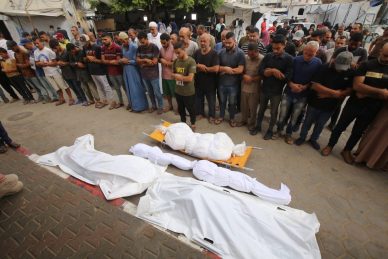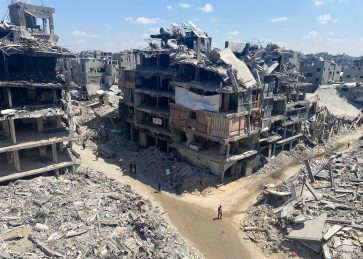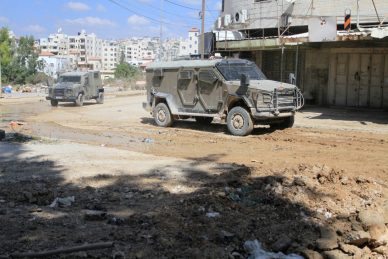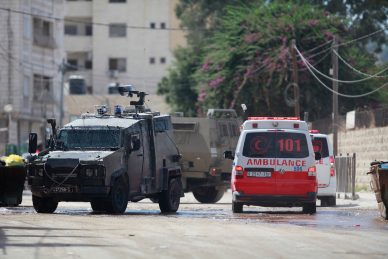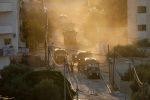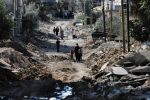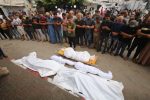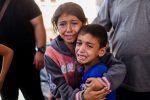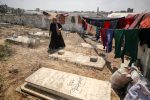GAZA, (PIC)
Maysaa Al-Maghrebi is facing extreme difficulty in finding clothes that fit her children, with the limited supply in the markets and the closure of many shops due to the blockade and the destruction of the economic and industrial infrastructure in the Gaza Strip.
The mother, along with her family of five children, fled to the city of Deir Al-Balah in central Gaza Strip when the war of genocide broke out on Gaza, like thousands of other displaced people. She did not bring much with her, thinking the war would not last long.
She says that each of her children has a limited number of clothes that have become worn out due to constant use, in addition to the environment they live in under a tent, which has further worn out their clothes as the children play in the sand all day.
Al-Maghrebi adds that she has searched in most of the shops in Deir Al-Balah, hoping to find suitable summer clothes for her children, but her attempts have failed as the prices are four times the regular price, and most of the available clothes are made of a high percentage of nylon, “We live 24 hours inside a nylon tent, we can’t stand sitting in it, let alone wear clothes like that! Their skin will peel off.”
In the first months of the devastating war on Gaza, the shops in the displacement areas witnessed a high influx of displaced people and citizens seeking to obtain the clothes they needed after losing their homes due to the bombardment or being stripped of what they had brought with them on the path of displacement.
Aid from relatives and friends
The hardship facing Maysaa may appear simple compared to what Rasha Al-Haddad, who is just weeks away from giving birth to her new baby, is expecting.
The mother says she was unable to buy clothes for her newborn due to the lack of baby clothes of all sizes in the markets.
Al-Haddad points to the specificity of newborn clothes in the hot and humid summer months of the Gaza coastal area, “Newborns need cotton clothes that suit their sensitive skin in the first months of their lives.”
To solve this dilemma, Al-Haddad resorted to borrowing some newborn clothes and essentials from her relatives and friends, “There’s nothing we can do, I’ve scoured the entire market but couldn’t find any newborn clothes.”
The Israeli occupation authorities have closed the Gaza Strip crossings for 10 months, while the industrial sector has completely stopped due to the destruction of more than 90% of the components of the industrial infrastructure, factories, energy, and others.
According to a joint report by the United Nations and the World Bank issued early last April, the value of the damage to Gaza’s infrastructure amounted to about $18.5 billion.
Alternative choices
As for Osama Mohammed, he says he resorted to the used clothes sold on the sidewalks to buy some summer pieces for his children, “We were displaced in the winter and only brought winter clothes with us, and we need to buy summer clothes for my daughters even if they are used.”
He points out that some of the clothes sold on the sidewalks were salvaged from the ruins of destroyed homes, “but that does not mean they are sold at cheap prices, the price of a single item for an adult can reach 40 shekels, and this is not a small amount given the difficult living conditions that everyone in Gaza is suffering from, in addition to the scarcity of cash liquidity.”
The heavy toll of war
In this context, merchant Muhammad Abu Hilal says that the war has cast its heavy toll on all levels, the most prominent of which is the economic aspect, with the economic shocks it has caused, pushing hundreds of thousands of Palestinians into the cycle of poverty.
He explains that hundreds of merchants have lost their businesses, and many have lost their factories in the industrial zone that supplies the local markets with domestic products.
Abu Hilal emphasizes to the Palestinian Information Center the tragic situation of citizens, as they have lost their purchasing power due to the high prices caused by the war as a result of the closure of crossings, the destruction of commercial and industrial movement, and public and private facilities, as well as the scarcity of supply in the markets.
He says, “Today, people can barely secure their daily sustenance, so how can they afford to pay the price of new clothes that are sold at multiple times their pre-war price? For example, a child’s summer blouse is sold for 60 shekels, which is 4 times its pre-war price, due to the shortage of available quantities in the markets.”
He points out that the same reason drives people to buy used clothes, which are also sold at 10 times their pre-war real price.
According to UN estimates, restoring the social and economic conditions that prevailed before the war on Gaza will take decades.
The United Nations Conference on Trade and Development (UNCTAD) affirms, in a report released in early February of this year, the urgent need to break the cycle of economic destruction that has made 80% of the population dependent on international aid.
UNCTAD estimates indicate that Gaza’s gross domestic product shrank by 4.5% in the first three quarters of 2023. The war has accelerated this decline and accelerated the contraction of GDP over the entire year by 24% and a 26.1% decline in per capita GDP.
Since October 7, 2023, the Israeli occupation army has been waging a war of extermination on Gaza, which has so far resulted in more than 39,000 martyrs, more than 90,000 injured, mostly children and women, the displacement of about 1.9 million people, and more than 10,000 missing, amid massive destruction of health, educational and economic infrastructure, and famine that has claimed the lives of dozens of children, according to United Nations data.


